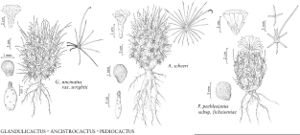Ancistrocactus
Cact. 4: 3. 1923.
| Taxon | Illustrator ⠉ | |
|---|---|---|
 | Glandulicactus uncinatus var. wrightii Ancistrocactus scheeri Pediocactus peeblesianus subsp. fickeiseniae | John Myers John Myers John Myers |
Plants erect, unbranched (few branched from near base), sometimes deep-seated in substrate with only broad top visible. Roots diffuse, short, succulent taproots, or tuberlike. Stems unsegmented, dark green or dark gray-green to pale blue-green, spheric to cylindric, sometimes stipitate, 2–9 (–15) × 2–8 (–10) cm; ribs 8 or 13 (0 in young, tuberculate plants), indistinct (in A. brevihamatus) or distinct (in A. scheeri), crests deeply notched adaxial to each areole, making ribs prominently tuberculate; tubercles slightly coalesced into ribs with advancing age of plant, ± conic, protruding 1 cm or less on young plants and of ribs on adults; areoles ca. 12–18 mm apart along ribs, nearly circular at sexual maturity, newer areoles more elongate, on oldest parts of stem adaxially forming narrow grooves extending to axils, felted; areolar glands often conspicuous within grooves, hemispheric; cortex and pith conspicuously mucilaginous. Spines 10–26 per areole, sparse to densely obscuring stems, grayish, whitish, or yellowish, reddish or blackish in proximal and distal portions, acicular or somewhat flattened, to almost papery, minutely canescent; longest spines 9–25 (–45) × 0.4–0.8 mm; radial spines 7–22 per areole, straight, longest spines 5–18 (–29) × 0.1–0.5 mm; central spines (3–) 4 (–5) per areole (solitary abaxial central spine plus straight, flat adaxial central spines), principal central spine porrect, hooked (absent on immature plants and youngest adults of some A. brevihamatus populations). Flowers diurnal, near stem apex at adaxial edges of areoles on young adults, at axillary ends of short areolar grooves in older plants, funnelform, often narrowly so, expansion often restricted by adjacent spines, 2.5–4 × 1.5–4 cm; outer tepals entire to denticulate; inner tepals seldom showy: white, brown, pink, yellow, or green (brightest green in some A. scheeri), 2.5–17 (–24) × 0.6–5 (–7) mm, margins entire; ovary sparsely scaly, spineless, hairless; scales minutely fringed; stigma lobes 4–10, white, green, yellowish, or rose-pink, 1.5–2.5 mm. Fruits indehiscent, green, sometimes suffused pink or brownish purple, drying to yellowish, tan with dull pink tinge, or white, ovoid to cylindric, (9–) 15–25 (–31) × (3–) 6–9 mm, weakly succulent (sometimes drying to a papery shell), scaly, spineless, hairless; floral remnant persistent. Seeds black or very dark reddish-brown, spheric to helmet-shaped or reniform, 1.5–2 mm, glossy, papillate or minutely so; testa cells flat to weakly convex. x = 11.
Distribution
Arid regions, sw United States, Mexico
Discussion
Species 2 (2 in the flora).
Ancistrocactus is sympatric with three other hook-spined species: Glandulicactus uncinatus, Ferocactus hamatacanthus, and Hamatocactus bicolor. Ancistrocactus has only straight radial spines (Glandulicactus has strongly hooked abaxial radial spines), broadly rounded tubercles of ribs (those of Hamatocactus bicolor and Ferocactus hamatacanthus var. sinuatus are laterally compressed), and plants of reproductive age are much smaller than plants of Ferocactus hamatacanthus var. hamatacanthus.
Selected References
None.
Lower Taxa
Key
| 1 | Roots short, conic taproots or diffuse, without constriction between stem and root; radial spines 7-14 | Ancistrocactus brevihamatus |
| 1 | Roots fleshy, tuberlike taproots with bulbous swellings and/or bulbous secondary roots, always separated from stem by fragile constriction; radial spines 13-28 | Ancistrocactus scheeri |